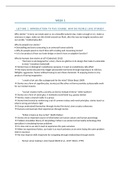WEEK 1
LECTURE 1. INTRODUCTION TO THIS COURSE. WHY DO PEOPLE LOVE STORIES?
Why stories? “A story can sneak upon us on a beautiful autumn day, make us laugh or cry, make us
amorous or angry, make our skin shrink around our flesh, alter the way we imagine ourselves and
our worlds.” (Gottschalk,p.82)
Why do people love stories?
• Storytelling and story consuming is an universal human activity
• Why do people spend so much time with creating and consuming stories?
• Is it a by-product of how our brain design or does it have an adaptive function?
Why do humans love stories at all? (Gottschall, 2012)
- “the brain is not designed for a story; there are glitches in its design that make it vulnerable
to story” (Jonathan Gottschall)
Stories have no biological/ evolutionary purpose, it is just an evolutionary side effect
We enjoy stories because they trigger pleasurable hormones through exposing us to wild sex,
fistfights, aggression, humor without having to earn these chemicals enjoying stories is a by-
product of having imagination
- “a work of art acts like a playground for the mind” (Brian Boyd, 2009)
Stories are a form of cognitive play, stories just like other art forms provides a pleasurable work
for our mental muscles
- “real art creates myths a society can live by instead of die by” (John Gardner)
Stories are a form of social glue, it maintains social bond (e.g. gossip stories)
Stories create a shared reality in a group
Stories bind society by reinforcing a set of common values and moral principles: stories teach us
what is wrong and what is right
Groups understand themselves through stories (his-story): story creates coherence
Humans communicate their experiences through stories
- “fiction is twice as true as fact” (Keith Oatley)
Stories are an important source of information on human culture and human psychology
Problem simulation theory of storytelling: Fiction is an ancient virtual reality technology that
specializes in simulating human problems
It is low-cost as we don’t need to experience the pain ourselves
When we experience fiction, our brain is as much activates as we were facing the same problem
(mirror neurons)
We may improve skills important for navigating through relationships through stories
- Human sense-making is story-based (Bietti et al., 2019; Weick, 1995)
,Homo Narrans (Fisher, 1975): “We dream in narrative, daydream in narrative, remember, anticipate,
hope, despair, believe, doubt, plan, revise, criticise, construct, gossip, learn, hate and love by
narrative. In order really to live, we make up stories about ourselves and others, about the personal
as well as the social past and future.”
people are story telling animals and the human mind works with stories. To connect the past and
the future stories are being used.
(Barbara Hardy, 1968)
Why put your message in a story form?
to conclude, the situations and episodes in narrative have a close link to everyday experiences, so
the comprehension mechanisms are much more natural than during the comprehension of other
discourse genres such as argumentation, expository text, and logical reasoning.
(Graesser et al., 2002, p.229)
For example: If you want to make a connection between a product and an individual being, a story
can be the bridge of connection. When you tell a meaningful story of your product, then you will
evoke a lot of memories/emotions/thoughts (e.g. marketing/branding).
, LECTURE 2. WHAT IS A STORY?
Story = Narrative
How do you know whether a message is a story?
What is a story?
“a series of logically and chronologically related events” (Mieke Bal, p. 5, 1985)
• Logic: events have causal relationship with each other
• Chronology: events relate to each other in terms of time
“A narrative is any (chronological), cohesive and coherent story with an identifiable beginning,
middle, and end that provides information about scene, characters, and conflict; raises unanswered
questions or unresolved conflict; and provides resolution” (Hinyard and Kreuter, 2007, p. 778).
Components of narrativity (Ryan, 2007)
1. Space:
a. Narratives must be about worlds populated with individual entities
abstract entities, e.g. atoms, clouds
2. Time:
a. Narrative worlds must be situated in time and experience significant changes
static events
b. Changes to narrative worlds must be caused by non-habitual physical events
repetitive events, changes caused by natural evolution, e.g. aging
3. Agency:
a. Some narrative event participants must be intelligent beings with agency
weather report
b. Some narrative events must consist of purposeful action by the agents
internal monologues
4. Causality and form:
a. The sequence of narrative events must be causally linked and lead to closure
unconnected events
b. At least one of the narrative events must be asserted as fact for the story world
instructional texts
c. The story must communicate something meaningful to the audience.
Mary was poor then got rich
Final definition (for today)
A narrative is a cohesive, causally linked sequence of events that takes place in a dynamic world
subject to conflict, transformation, and resolution through non-habitual, purposeful actions
performed by characters (Breaddock & Dillard, 2016).




